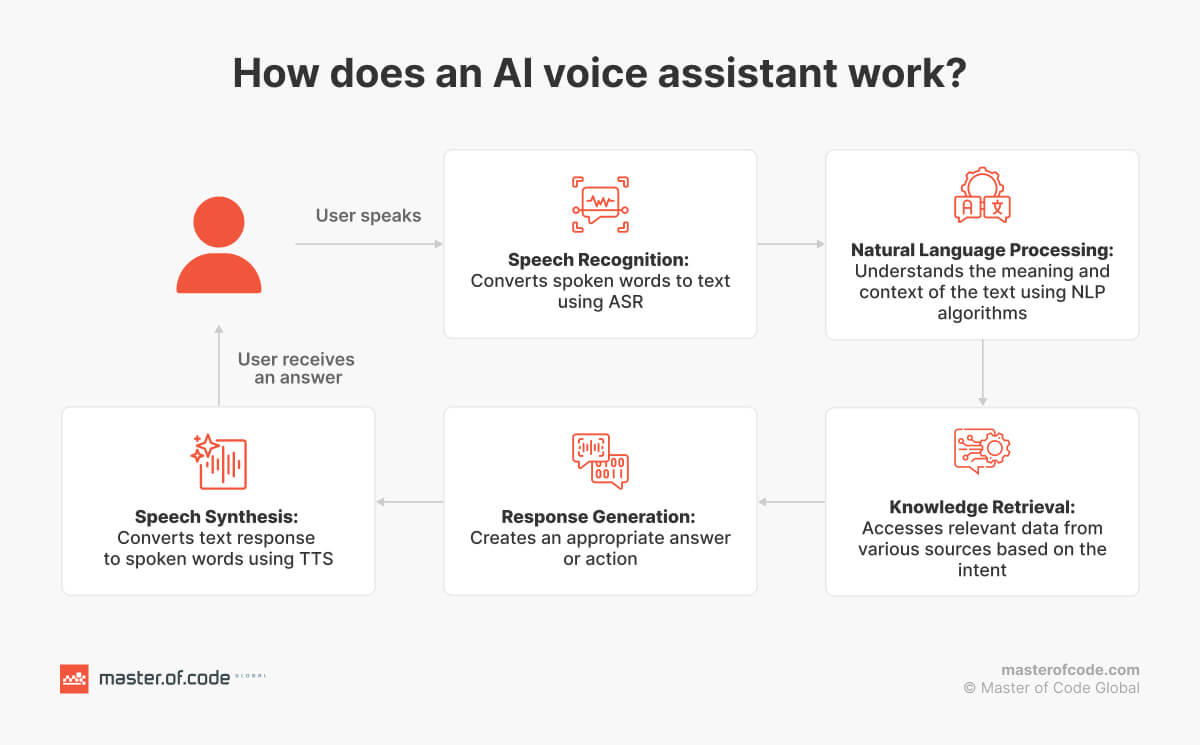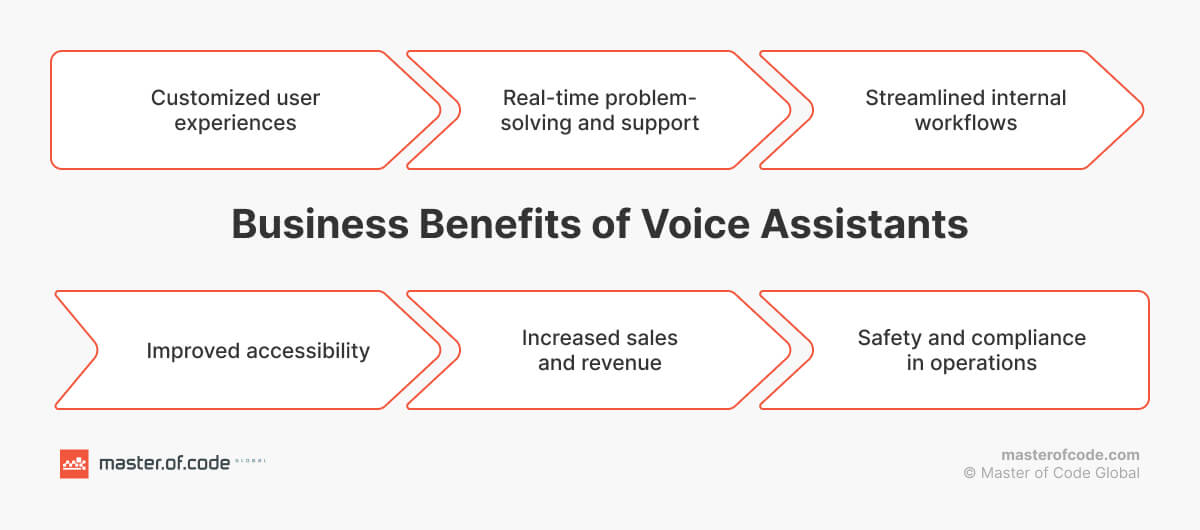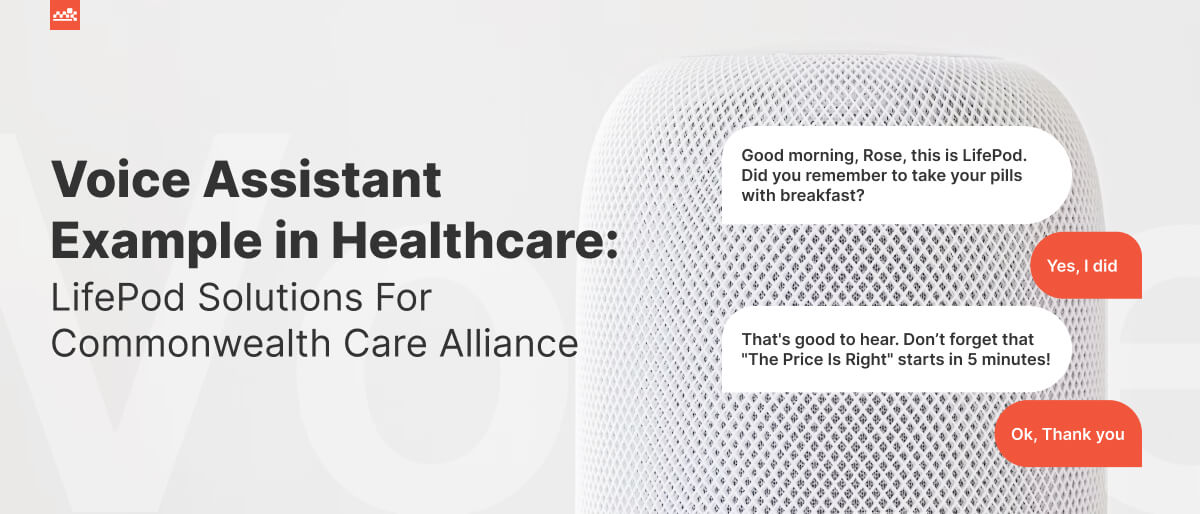Amazon’s Alexa, Apple’s Siri, Microsoft’s Cortana, and Samsung’s Bixby are prime voice assistant examples (VAs), but the technology itself is no longer limited to megacorporations. Instead, these intelligent systems are increasingly being embraced at the enterprise level. This new wave of adoption is evident in recent statistics:

- In the US, there are about 146 million voice assistant users as of 2024, with projections indicating that this number will rise to 157.1 million by 2026. Fifty percent of U.S. consumers use voice search daily, and 67% across all age groups report being highly likely to rely on it when looking for information.
- Global Banking and Finance Review reported that 88% of global business leaders think VA technology has the potential to help grow their brand.
- According to the State of Voice Report by Deepgram, 82% of companies are already utilizing voice technology, and 85% anticipate widespread deployment within the next five years. Additionally, 66% view voice-enabled experiences as critical to their future business strategies.
- Executives have high expectations for voice technology, with 87% aiming to enhance productivity, 77% seeking new business opportunities, and 62% looking to boost revenue. In terms of benefits already experienced, 83% cite convenience and speed, 77% report improved customer support, and 74% highlight the positive impact on brand identity and customer experience.
Overall, artificial intelligence and machine learning (ML) have breathed new life into VAs and are now reshaping consumer behavior trends. These changes open up a plethora of opportunities for businesses to capitalize on.
Wondering how voice assistants can elevate your business? Keep reading to explore their unique features, sector-specific use cases, and why investing in VAs is becoming a must for forward-thinking companies.
Table of Contents
What You Need to Know About Voice Assistants
To put it simply, voice assistants are intelligent software programs fueled by artificial intelligence, allowing seamless interaction with devices or services using natural language. In the business realm, they offer significant advantages beyond their familiar consumer applications.
Imagine healthcare providers using the VA to instantly access personal records and automate administrative tasks, freeing up valuable time for patient care. Picture retailers offering personalized shopping recommendations and gathering buyer feedback through natural conversations. In the automotive industry, these solutions enhance in-car infotainment and improve driver safety with hands-free controls. And in banking, they’re available 24/7 to handle inquiries and enable secure voice-activated transactions.
The use cases and benefits of these smart tools are vast. By optimizing processes, boosting productivity, and elevating customer engagement, they enhance organizations’ competitiveness. Now, let’s explore the inner workings of voice assistants and reveal the technology behind their capabilities.
How Do These Systems Work
The seemingly effortless interaction with VAs belies the intricate processes happening behind the scenes. Let’s take a closer look at how these amazing technologies function.

- It all starts with your voice. When you speak a command or ask a question, the voice assistant captures your words as audio signals.
- The captured audio is then transcribed into text with the help of Automatic Speech Recognition. ASR employs complex algorithms to analyze the sound patterns and match them to corresponding words and phrases.
- During the next stage, Natural Language Processing (NLP) dissects the text, deciphers its meaning, and identifies the person’s intent. This involves understanding the context, recognizing entities, and extracting key data.
- Armed with the user’s aim, the voice assistant taps into its vast knowledge base or accesses external sources to retrieve relevant facts.
- The gathered information is then processed to generate an appropriate reply, which could be an answer to an inquiry, an action to be performed, or even a follow-up question to clarify one’s intention.
- Finally, the textual response is converted back into spoken words using Text-to-Speech (TTS) technology. The synthesized speech is then played back to the user through the device’s speaker.
- And voila! You hear the voice assistant’s answer, completing the cycle of communication.
Advanced Capabilities of Digital Voice Helper
Now that we’ve discussed the underlying mechanics, let’s dive into the state-of-the-art features that make VAs even more versatile and essential for businesses.
- Voice command execution. This fundamental feature enables voice assistants to execute commands such as setting reminders, controlling equipment, or scheduling meetings. The seamless ability to carry out tasks hands-free boosts productivity and user satisfaction.
- Contextual awareness. A major advancement in voice technology is the capability of agents to understand and remember the context of previous conversations. This allows for more natural and fluid communication, where you don’t need to repeat information or clarify earlier points.
- Multi-language support. VAs are becoming increasingly global, offering aid in multiple languages. Such a function broadens their appeal across different regions and cultures, ensuring that businesses and consumers worldwide can interact with the tool in their preferred language.
- Integration with third-party services. These systems are now compatible with a range of third-party solutions and apps. For example, voice-based Conversational AI can be embedded across various client service touchpoints, allowing companies to automate communication through chatbots, streamline customer care, or enhance employee workflows.
- Personalization. Voice assistants can also tailor responses and recommendations as per personal preferences, habits, and past exchanges. The personalized touch makes interactions feel more relevant and improves the experience over time.
- Voice biometrics. For added protection, some applications use voice authentication to identify users according to their unique vocal characteristics. They ensure that only authorized people access certain features or private data, adding a layer of security to such conversations.
With these high-end attributes in mind, it’s no surprise that brands are progressively turning to technology, not just for convenience, but for the strategic advantages they offer.
Why Are Businesses Investing in Voice Assistants?
As noted earlier, these assistants typically found on mobile devices like Siri and Google Assistant are examples of Voice User Interfaces (VUIs). Although VUIs existed as early as the 1950s, greater technological challenges meant that modes of communication like typing took precedence in most business implementations.

However, most of those technological barriers have been overcome, and VUIs of today show many significant advantages over their counterparts, such as:
- Speed. As accustomed as some of us have become to typing, speaking (or dictating messages) is still a much faster way of communicating. A study showed that even expert typists were slower than modern VUIs at jotting down notes.
- Hands-free. One of the primary perks of using VAs is that you can operate with both hands unencumbered. This further expands the possibility of multitasking, particularly for employees who frequently should stop what they are doing in order to respond to an urgent message or send a file to a colleague. Not only can voice assistants raise productivity in and around the workplace, they can also improve safety. In numerous cases, communicating through voice instead of typing is more practical and safer.
- Ease-of-use. Speaking is natural, more so than keyboarding, even in 2024. This becomes especially important when the technology is consumer-facing. For instance, a parking lot’s automated toll booth or an iPad taking customer feedback are far more intuitive when they are created to understand the user’s verbal commands and provide assistance. Not to mention, VUIs began their comeback only recently, so they are still a novelty that many customers would enjoy.
- Intonation. Text messages often lack factors that convey emotion, leading to ambiguity and even miscommunication. Voice assistants, on the other hand, are designed with the tone, volume, intonation, and rate of speech in mind to express a wider array of emotions.
- Screenless devices. Finally, with wearable tech with displays like smartwatches and IoTs like smart speakers, voice is the only way of interacting effectively. This is both an incentive to invest in VUIs as IoTs will become more commonplace and also a benefit of already pursuing this technology.
How Businesses are Using Voice Assistants or VUIs in 2025
The ability to speak and get things done has virtually unlimited applications, but the following use cases explore some popular implementations of voice assistants or VUIs in general:

Embeddable Voice Assistant Technology for Chatbots
Text-based chatbots have become commonplace, especially in retail, eCommerce, and banking applications (check out the evaluation report on top Canadian banking virtual assistants). And since improving customer experience is the top priority, many businesses want to add voice recognition abilities to their existing applications.
Embeddable Voice Assistant is a technology developed by Master of Code Global. It allows mobile apps to communicate with Microsoft Azure Bot via Direct Line or any other bot framework. This brings VA capabilities to available systems at a fraction of the cost of developing one from the ground up.
Voice AI Agent for Financial Services
A cutting-edge Voice AI solution designed by Master of Code Global is transforming the way financial institutions handle credit account inquiries. This advanced system manages over 156,000 calls per month, automating authentication, information delivery, and transaction processing, all while ensuring top-level security and fraud protection.
With a 94% first-call resolution rate and $7.7M in annual savings, this AI-powered solution delivers an 88% customer satisfaction score, proving its efficiency in streamlining customer interactions and reducing operational costs without sacrificing security.
Elevating Organizational Efficiency
Apart from enhancing the consumer experience, an AI-based voice assistant for business offers great potential to increase productivity levels. Results from a survey indicated that using digital assistants can compensate for up to 6.2 billion work hours. This is not just effective; it allows companies to achieve superhuman performance efficiency and minimize human labor wastage.
Automated IT Helpdesk
In the realm of corporate effectiveness, voice AI for business is modernizing IT helpdesks. By automating routine tasks like resetting logins and answering FAQs, these intelligent virtual assistants offer 24/7 support to employees. They significantly reduce the need for human intervention. This streamlines services and cuts down on the operational costs associated with running an IT helpdesk. The transformation here is akin to enhancing an internal customer service department with the power of conversational UI, thus boosting overall employee output.
HR Tasks
The Capgemini Research Institute Survey found that enterprises increasingly rely on highly accurate natural-language understanding (NLU) to trigger automated workflows with voice commands, especially in document management, client relations management, and HR. AI-powered voice assistants can also process and analyze huge chunks of data. This can be used to automate repetitive or labor-intensive tasks.
An interesting implementation of this can be found in numerous HR departments worldwide. Managers turn to VAs to assess multiple recruitment databases simultaneously and add a conversational medium between the applicants, which can be further employed for computerized screening. Furthermore, VUIs like Darwin give employers an easy way to evaluate team performance and view attendance, payrolls, etc.
Efficient Meeting Management
Voice technology is changing the face of corporate meetings through systems like Amazon’s Alexa for Business. These tools allow the scheduling of rooms and AV control via voice commands. Setting up and managing calls is now more efficient. The feature integrates seamlessly with online calendars and other services. Sessions begin swiftly, with minimal setup time. This enhances the call experience greatly.
Inventory Management for Office Supply Rooms
VAs are bringing a new level of efficiency to storage areas. Audio commands now handle tasks like replenishing printer paper or initiating orders. This is especially useful in dispatch and delivery rooms. AI voice assistants are innovating these processes, making them simpler and smoother. As a result, backend operations in businesses are streamlined significantly.
Collecting Strategic Consumer Insights
VA bots can gather client data about their interests quickly and efficiently. A company can use this data to understand trends in customer demands and develop products and marketing strategies accordingly. The global value of transactions made through voice assistants in eCommerce is estimated to be around $19.4 billion, a 400% increase within two years.
Therefore, global brands like Johnnie Walker and L’Oreal are partnering with companies like Amazon to make their product information easily accessible through Alexa and other VUIs. The apps have such a large market that firms have started considering voice technology in design, delivery, and promotional tactics to better connect with their customers.
Advertising and Marketing
The eCommerce global market has risen to a noteworthy $6.3 trillion, a 177% increase since 2019. As a result, many businesses have switched to digital marketing to support this shift. Mass outreach, especially out-of-home (OOH) advertising, is becoming a less appealing approach for enterprises. Companies are adjusting their investment strategies in response to the noticeable decline in the international print ad market, indicating a transition towards other forms of promotion.
In fact, as consumers spend more time on their smartphones and computers, the most effective method to advertise is shifting in favor of voice technology. As customers embrace VAs as a normal part of their lives, the way they interact with marketing campaigns is also changing considerably.
Forecasts suggest that global marketing efforts will continue focusing heavily on VAs. Some of the reasons behind this shift include:
- Voice assistants present personalized recommendations to users, enhancing the shopping process and leading to improved sales outcomes;
- Strategies such as upselling and cross-selling can be employed more naturally through voice. Check out the latest trend of Chatbots in Conversation Marketing;
- VAs provide direct consumer insights and feedback to marketers.
Inclusiveness and Accessibility
Every organization has consumers with motor and linguistic disabilities that make it difficult for them to use certain types of interfaces — handheld or text-based options being one of them. And even though nearly one billion in the world experience some form of disability, most computer systems aren’t designed for inclusiveness — basically, creating a barrier for almost 15% of the population. Federal legislation like the Americans with Disabilities Act (ADA) is helping improve the situation, but adherence can be costly (non-compliance even more so).
This is where voice assistants offer a cost-effective solution by providing both verbal and visual aids. They do not require owners to read the text on the screen or be able to touch it (type responses back into it). In fact, a peer-reviewed study from 2020 found that users with impairments could effectively adopt VA and take control over daily tasks (which would be a great boost for mental health as well). VAs also ensure that individuals with temporary disabilities like hand fractures can still utilize their favorite mobile apps.
Voice Assistant Use Cases Across Industries
Banking
In the banking industry, voice assistants are redefining customer service and operational efficiency. Common queries like account balances, ATM locations, and address updates are handled smoothly by VAs. They offer quick and accurate responses that enhance user experience.
Beyond basic inquiries, these AI-powered agents intelligently upsell and cross-sell products, provide personalized suggestions based on user profiles, and even detect fraudulent activities through advanced vocal and behavioral analysis. This level of personalization and security is a significant leap from traditional IVR systems. VAs enable banks to deliver more tailored and secure services to their customers.
Organizations that have integrated VAs report substantial improvements:
- a reduction in customer service calls by over 20%;
- a decrease in client loss by 20%;
- a notable drop in wait times on calls, often by at least 5 minutes;
- a 20% increase in first-call resolution of problems or queries.
These numbers highlight the effectiveness of VAs in enhancing consumer satisfaction and securing the bottom line.
A compelling example of voice assistant in banking is Garanti Bank’s implementation of the Mobile Interactive Assistant (MIA). Customers can use MIA for their mobile app through voice commands. Communication is not strictly one-directional. The tool also notifies users about recent promotions/offers and analyzes their usage patterns to create a personalized experience.
This is a big move as it helped dispel some of the security concerns surrounding voice-based chatbots. Since Conversational AI in banking continues to develop and embrace such technologies, the adoption rate in the sector will rise. That said, VA still has some ways to go before it becomes mainstream in this domain, mostly because of the safety challenges it entails.
Travel & Hospitality
Voice assistants are reinventing the way services are delivered to guests. VAs offer quick access to information about hotel amenities, local attractions, and dining options. This leads to a greatly upgraded visitor experience, adding a layer of convenience and personalization.
These tools also simplify tasks such as checking in, setting alarms, or adjusting room controls. This seamless interaction makes stays more enjoyable and reflects the industry’s commitment to applying cutting-edge technology for superior service.
VAs also significantly streamline hotel operations. By efficiently managing routine inquiries and requests, they allow hotel staff to focus more on providing personalized, high-touch services. This shift towards automation translates into reduced wait times and a responsive assistance environment. Voice technology gains traction in hospitality, promising enhanced efficiency and guest experiences.
Healthcare
Voice assistants in the medical field are modernizing patient care and clinical workflows. They efficiently manage routine tasks, easing the administrative load on staff. For example, these assistants handle appointment scheduling and medication reminders effectively. This reduces no-show rates and improves adherence to treatment schedules. VAs support providers by automating functions like medical note transcription. Accurate real-time data capture into electronic health records (EHRs) becomes seamless. Consequently, voice assistants offer more than convenience; they are vital for improved services.

Commonwealth Care Alliance has been piloting the use of voice technology for enhanced care, specifically LifePod Solutions. It targets those with complex necessities, especially with disabilities or impairments. Members employ voice commands for tasks, aiding those with specific challenges. The technology enables hands-free communication and management of personal care schedules. This implementation reflects the potential of such applications to significantly improve the quality of life and clinical administration for individuals with various needs and difficulties.
Automotive
For this sector, voice assistants are key, boosting the driving experience with hands-free use and enhanced features. They allow drivers to control navigation, music, and climate via speech, improving multitasking safety and efficiency. Voice technology in cars offers more than basic commands. It provides real-time traffic updates, route suggestions, and remote car control. This is crucial in autonomous and software-defined autos for smooth human-vehicle interaction.
VAs in cars are vital for the shift to more self-sufficient driving. They offer intuitive interactions, building trust with AI. These tools go beyond convenience, becoming essential for car functions and safety. In future automotive technology, voice assistants will be central. They will connect drivers, vehicles, and our increasingly connected world, leading to safer, more interconnected, and more efficient transportation.
eCommerce and Retail
A recent report on voice and text-based assistants found that consumers of the retail industry demonstrated a 15% higher future preference for voice assistant technology over chat assistance. There are a few reasons behind this shift, one of the most prominent ones being that many online shoppers need a more efficient alternative to browsing dozens of product pages in modern eCommerce stores. AI shopping assistant effortlessly directs them to the relevant products through a single voice command.

A prime VA example in retail is Nike’s collaboration with Google. Together they launched a voice-activated shopping experience for the Adapt BB sneakers. Fans were invited to purchase these shoes using Google Assistant during the NBA halftime. This unique approach showcased the convenience of voice technology in shopping and its powerful impact on consumer behavior. Remarkably, the shoes sold out within 6 minutes. Such a success demonstrates the effectiveness and potential of VAs in the sector.
The Future of Voice: A Glimpse into Tomorrow
As we look towards the future of voice assistants, they are poised to become an even more indispensable part of our daily lives. Their evolution and integration across various platforms are foreseen to grow substantially:
- The global voice assistants market was valued at US$ 4,662.7 million in 2022. It is anticipated to reach US$ 38,539.5 million by 2031, growing at a CAGR of 26.45% from 2023 to 2031.
- In 2023, 142.0 million people in the US, or 42.1% of the population, utilized these digital apps. Over half of internet users in the US will likely have a VA by 2026.
- In 2027, 89.7% of US VA owners will engage with the technology on smartphones. The use of these agents in smart homes, connected cars, and TVs is also expected to broaden.
- State of Voice Report by Deepgram revealed that 72% of business leaders believe that speech-based experiences will achieve widespread adoption within the next one to five years. The survey also highlights that 56% of respondents expect life-like voice assistants to emerge within 1-3 years, while 40% consider human-level interactions will be achieved in less than a year.
- With advancements in Generative AI, this technology is positioned to gain even more influence. In fact, 55% of businesses plan to pilot or implement artificial intelligence in their client support voice channels within the next 6 to 24 months.
- IBM too emphasizes this trend: 27% of organizations are already using GAI-powered spoken communication with their customers, and by 2025, 75% predict having these solutions in place.
Voice assistants’ expanding presence across diverse industries signifies a future where verbal interaction is an even more ubiquitous and essential aspect of our digital expertise. Moreover, with the rise of LLMs, they are set to advance even more, offering highly personalized and contextually aware conversations. Companies will get the opportunity to secure a more natural, intelligent, and seamless user journey, ultimately driving greater client engagement and operational efficiency.
Where Conversational User Interface Is Headed
Voice assistants are part of a broader spectrum of Conversational User Interfaces (CUIs) that also include text-based chatbots. The emerging popularity of these CUIs is the result of a major global shift to make everything conversational – from controlling your home electronics to creating a digital shopping list.
But, like all consumer trends, will conversational user interfaces like VAs and bots go out of fashion? Perhaps at some point, but certainly not for the next few decades. If anything, the technology will only grow as 64% of consumers want their AI virtual assistants to be more human-like.
For now, VA technology is changing the business landscape, as evidenced by the discussed voice assistant use cases. From eliminating human redundancies to making corporate operations more efficient to improving customer engagement, voice technology is being rapidly incorporated across industries globally.
With advancements in Generative AI, this domain is becoming more progressive and adaptive, offering organizations even greater opportunities for personalized, lifelike dialogues that help to build enduring relationships with brands.
For firms looking to stay ahead in this evolving field, employing VA technology is key. At Master of Code Global, a Conversational AI company, we help create dynamic voice solutions customized to your business needs. Our use of advanced NLP, NLU, and Gen AI transforms interactions into meaningful and engaging client experiences.
By recognizing voice inputs, converting them to text, generating intelligent responses, and voicing them back in real-time, we bridge the gap between human and machine communication, ensuring your organization not only keeps pace but leads in the digitalized era. Eager to boost connections with your audience through voice technology? Connect with Master of Code Global today and elevate your brand’s digital presence for lasting impact and growth.
Let us help you connect your brand with customers where they communicate today. Chat or voice.






